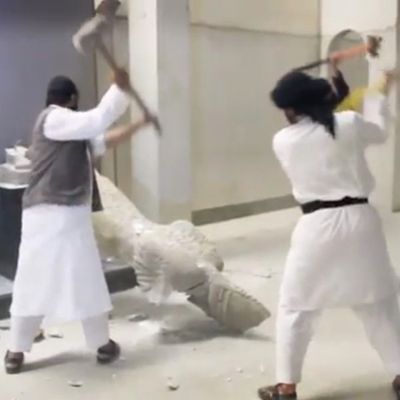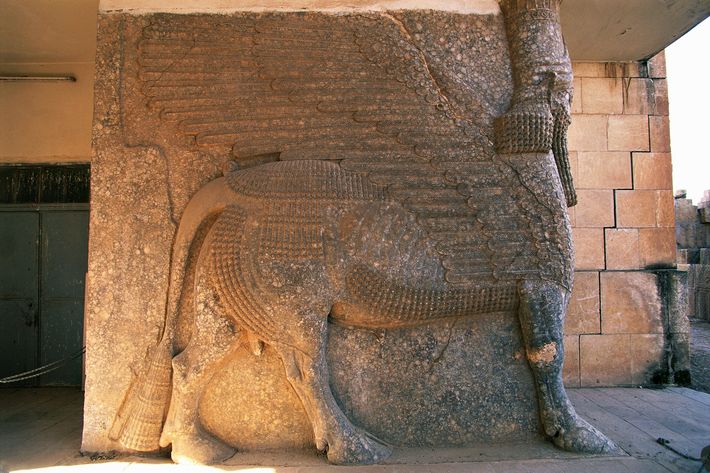
The Islamic State’s barbaric killings have horrified the world, but they aren’t only targeting the living. ISIS has been systematically looting and destroying ancient artifacts since it took over large swaths of Syria and Iraq, and it appears their efforts have been intensifying in recent months. Last week, the group released video of its members destroying ancient statues in the Mosul Museum, and on Thursday Iraq officials reported that they are bulldozing the Nimrud archaeological site.
“This destruction marks a new phase in the cultural cleansing perpetrated in regions controlled by armed extremists in Iraq,” said Irina Bokova, head of the United Nations Educational, Scientific and Cultural Organization (UNESCO). “It adds to the systematic destruction of heritage and the persecution of minorities that seeks to wipe out the cultural diversity that is the soul of the Iraqi people.” Bokova has called for an emergency meeting of the U.N. Security Council to discuss how to prevent further destruction.
Here’s how ISIS is trying to eradicate the region’s historical treasures.
Selling Iraqi artifacts on the black market
Under ISIS’s strict Salafi interpretation of Islam, worshiping at shrines and tombs is idolatrous — but that’s not the only reason the group destroyed dozens of mosques, churches, and other religious sites. ISIS began looting and selling off antiquities when it took control of large parts of Syria, and as Reuters notes, when they claimed Mosul and the Nineveh province in June 2014, they gained access to nearly 2,000 of Iraq’s 12,000 registered archaeological sites.
Last month, The Wall Street Journal reported that, like World War II’s “Monuments Men,” a group of academics are making their way through Syria and attempting to save artifacts being plundered by ISIS and other groups involved in the country’s civil war. ISIS is said to be encouraging civilians to plunder historic sites, and charging a 20 percent tax on anything they sell. Intelligence officials say looting is the terror group’s second largest source of income after oil.
Razing the Tomb of Jonah, and other religious sites
Within a month of the fall of Mosul, at least six Shiite mosques and four shrines to Sunni Arab or Sufi figures had been destroyed in the northern Nineveh province. ISIS posted photos of the landmarks being bulldozed or blown up with explosives on social media. Since then, dozens of religious sites have been vandalized and torn down.
One of the most notable losses is the Sunni Mosque of the Prophet Younis, which is believed to be the burial place of the prophet Jonah, who was swallowed by a whale. On July 24, ISIS posted a video on YouTube that showed the destruction of the site, which was significant to Jews, Christians, and Muslims. “They first stopped people from praying in it, they fixed explosive charges around and inside it and then blew it up in front of a large gathering of people,” a witness told The Guardian.
Burning books from libraries in Mosul
Over the past few months, ISIS has stepped up its efforts to purge libraries in Mosul of books they consider offensive (and locate valuable texts they can sell on the black market). According to the Associated Press, ISIS used trucks to remove thousands of texts from the Central Library of Mosul in January, presumably including collections of books from the Ottoman Empire, Iraqi newspapers from the early 20th century, and other ancient texts. “These books promote infidelity and call for disobeying Allah. So they will be burned,” said one militant.
ISIS reportedly raided many other libraries around the city and held book burnings in the street. A University of Mosul history professor told the AP that a Sunni Muslim library, the Mosul Museum Library, and the library of the 265-year-old Latin Church and Monastery of the Dominican Fathers have also been heavily damaged. There were conflicting reports on whether ISIS bombed the entire Central Library of Mosul or just burned many of its books.
UNESCO’s Irina Bokova said the destruction may be “one of the most devastating acts of destruction of library collections in human history.”
Demolishing artifacts in the Mosul Museum and at the Nergal Gate
Last week, ISIS released a five-minute video of its members smashing their way through the Mosul Museum, toppling statues and taking sledgehammers to centuries-old artifacts. “These antiquities and idols behind me were from people in past centuries and were worshiped instead of God,” explains an unnamed militant. “When God Almighty orders us to destroy these statues, idols and antiquities, we must do it, even if they’re worth billions of dollars.”
The video then shifts to the Nergal Gate, an entrance to the ancient Assyrian city of Nineveh, where the men use power tools to destroy a pair of massive statues of winged bulls with a human heads. Eleanor Robson, a professor of ancient Near Eastern history with the British Institute for the Study of Iraq, said the statues were created in the early seventh century B.C., “so they have stood there for nearly 3,000 years welcoming people into the city, and ISIS have now taken sledgehammers to them.’
There’s debate about whether some of the pieces were modern replicas, but Qais Hussain Rashid, director general of Iraqi museums at the Ministry of Antiquities and Tourism, said he believes most of the items shown in the video were real. “Mosul Museum has 173 original pieces, and there were preparations to reopen the Mosul Museum before ISIS invaded the city in June 2014,” he said.
“Bulldozing” the Nimrud archaeological site
Iraq’s Ministry of Tourism and Antiquities reported on Thursday that ISIS has damaged Nimrud, an archaeological site just south of Mosul, using heavy military vehicles. “The terrorist gangs of ISIS are continuing to defy the will of the world and the feelings of humanity after they committed a new crime that belongs to its idiotic series,” the ministry said on its Facebook page.
Nimrud is the site of an Assyrian city that dates back to the 13th century B.C. The site was looted during the Iraq War, but because of its remote location, many of the larger artifacts were undisturbed. The site has yielded jewelry, bas-reliefs, sculptures, and ivories, many of which have been moved to museums around the world. Pairs of its famous “lamassu” statues, which depict winged lions or bulls, are at the Metropolitan Museum of Art and the British Museum. Many areas have yet to be excavated, and the Iraqi government had nominated the site to be placed on UNESCO’s list of world heritage sites.

Ihsan Fethi, a member of the Iraqi Architects Society, told the New York Times, “I cannot even describe the immensity of this loss,” adding, “This is one of the most famous and probably one of the most important sites in the world.”
At the reopening of the Baghdad Museum last weekend, Iraqi prime minister Haider al-Abadi said his country would not let ISIS erase its history. “They are trying, with their barbarism and arrogance, to destroy the inheritance of humanity, the inheritance of Iraqi people and their civilization, [the] same way they destroyed humans,” he said. “I want to send clear message from here in Baghdad, that we will preserve this human civilization and its inheritance, and we will pursue those who are trying to destroy it.”






























